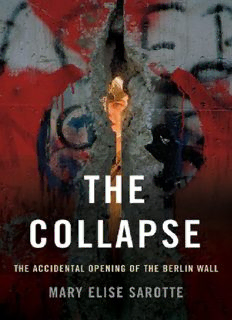
The Collapse: The Accidental Opening of the Berlin Wall PDF
Preview The Collapse: The Accidental Opening of the Berlin Wall
Praise for The Collapse “The fall of the Berlin Wall was one of the landmark events of the twentieth century, but this great change involved accidental and non-violent causes. In wonderfully readable prose, Mary Elise Sarotte tells a compelling story of how history works its surprises.” —Joseph S. Nye, Jr., Harvard University Distinguished Service Professor and author of The Future of Power “In The Collapse, Mary Elise Sarotte provides a needed (and highly readable) reminder that the peaceful culmination to 1989’s dramatic developments was in no way inevitable.” —General Brent Scowcroft, former National Security Advisor “Meticulously researched, judiciously argued, and exceptionally well written, The Collapse describes the fall of the Berlin Wall from an unprecedented perspective. Mary Elise Sarotte weaves together numerous German, American, and Soviet accounts, allowing the reader to crisscross the Berlin Wall on the eve and in the course of its collapse. It will come as a surprise to many that this climactic event in Cold War history resulted not from agreements reached in Washington, Berlin, Moscow, or Bonn, but from the uncoordinated actions of people on both sides of the Berlin divide. The Collapse makes it possible for those who made history in 1989 to speak in their own voices.” —Serhii Plokhy, author of The Last Empire: The Final Days of the Soviet Union “From a remove of 25 years, the fall of the Berlin Wall seems foreordained. In fact, as Mary Elise Sarotte shows, this historic moment was an improbable concatenation of events and decisions triggering in perfect if accidental sequence. Catastrophe at times was just seconds away. As someone who was in Leipzig and Berlin as the crucial events unfolded, I can say that Sarotte gets it exactly right, capturing the fear, confusion, courage, and growing excitement as hitherto ordinary people peacefully toppled the deadly barrier that symbolized the Cold War.” —Mike Leary, Pulitzer Prize–winning journalist “In her compelling and fast-paced narrative, Mary Elise Sarotte reminds us that the end of the Cold War was not foreordained, but that courageous acts by East German dissidents, offhand comments by GDR officials, and the actions of one perplexed border-guard changed the course of twentieth-century history. This is essential reading for those who want to understand the role of contingency and human agency in the unexpected opening of the Berlin Wall.” —Angela Stent, author of The Limits of Partnership: US-Russian Relations in the Twenty-First Century THE COLLAPSE THE COLLAPSE The Accidental Opening of the Berlin Wall MARY ELISE SAROTTE A Member of the Perseus Books Group New York Copyright © 2014 by Mary Elise Sarotte Published by Basic Books, a Member of the Perseus Books Group All rights reserved. Printed in the United States of America. No part of this book may be reproduced in any manner whatsoever without written permission except in the case of brief quotations embodied in critical articles and reviews. For information, address Basic Books, 250 West 57th Street, 15th Floor, New York, NY 10107. Books published by Basic Books are available at special discounts for bulk purchases in the United States by corporations, institutions, and other organizations. For moreinformation, please contact the Special Markets Department at the Perseus Books Group, 2300 Chestnut Street, Suite 200, Philadelphia, PA 19103, or call (800) 810–4145, ext. 5000, or e-mail [email protected]. Library of Congress Cataloging-in-Publication Data Sarotte, Mary Elise. The collapse : the accidental opening of the Berlin Wall / Mary Elise Sarotte. pages cm Includes bibliographical references and index. ISBN 978-0-46505690-3 (e-book) 1. Berlin Wall, Berlin, Germany,1961-1989. 2. Germany (East) —Politics and government—1989-1990. 3. Berlin (Germany)— History—1945-1990. I. Title. II. Title: Accidental opening of the Berlin Wall. DD881.S215 2014 943.087'8—dc23 2014026435 10 9 8 7 6 5 4 3 2 1 For Dianne and Al, Steve, and Mark It is not always going from bad to worse that leads to revolution. What happens most often is that a people that puts up with the most oppressive laws without complaint, as if it did not feel them, rejects those laws violently when the burden is alleviated. . . . The evil that one endures patiently because it seems inevitable becomes unbearable the moment its elimination becomes conceivable. —ALEXIS DE TOCQUEVILLE1 Contents List of Maps and Photos Abbreviations in the Captions, Maps, and Text Note on Names Introduction: Discovering the Causes of the Collapse PART I: THE STRUGGLE WITHIN THE SOVIET BLOC AND SAXONY Chapter 1 A Brutal Status Quo Chapter 2 Marginal to Massive Chapter 3 The Fight for the Ring PART II: THE COMPETITION FOR CONTROL IN EAST BERLIN Chapter 4 The Revolution Advances, the Regime Plays for Time Chapter 5 Failure to Communicate on November 9, 1989 PART III: THE CONTEST OF WILLS AT THE WALL Chapter 6 The Revolution, Televised Chapter 7 Damage Control? Epilogue Violence and Victory, Trust and Triumphalism Acknowledgments Brief Timeline of Major Events Highlighted in the Text Additional Information About, and Abbreviations in, the Notes and Bibliography List of Interviews Notes Bibliography Index Maps and Photos MAPS Map 1. Cold War Europe Map 2. Divided Germany in 1989 Map 3. Leipzig City Center and Ring Road Map 4. Divided Berlin in 1989
Description: